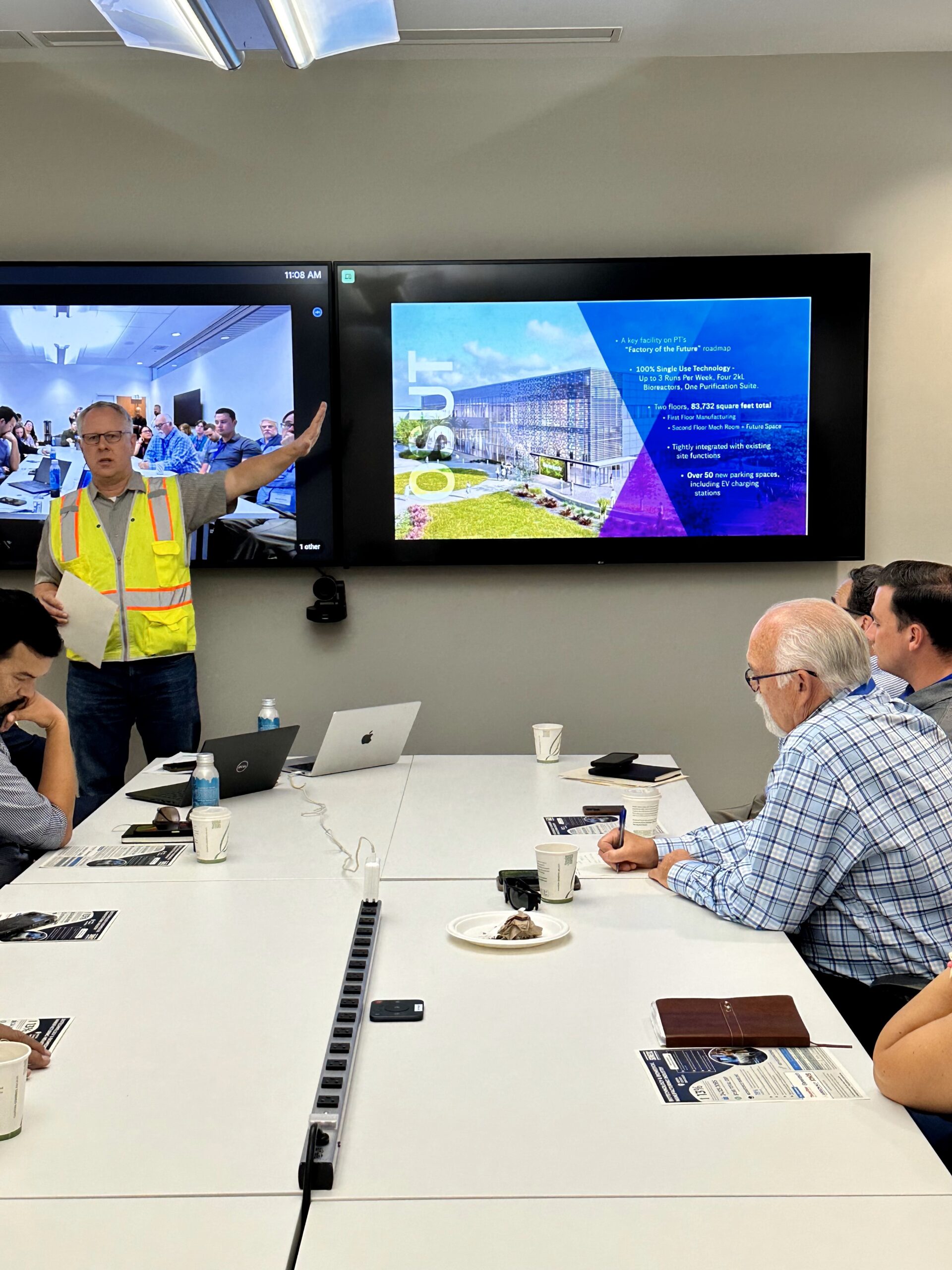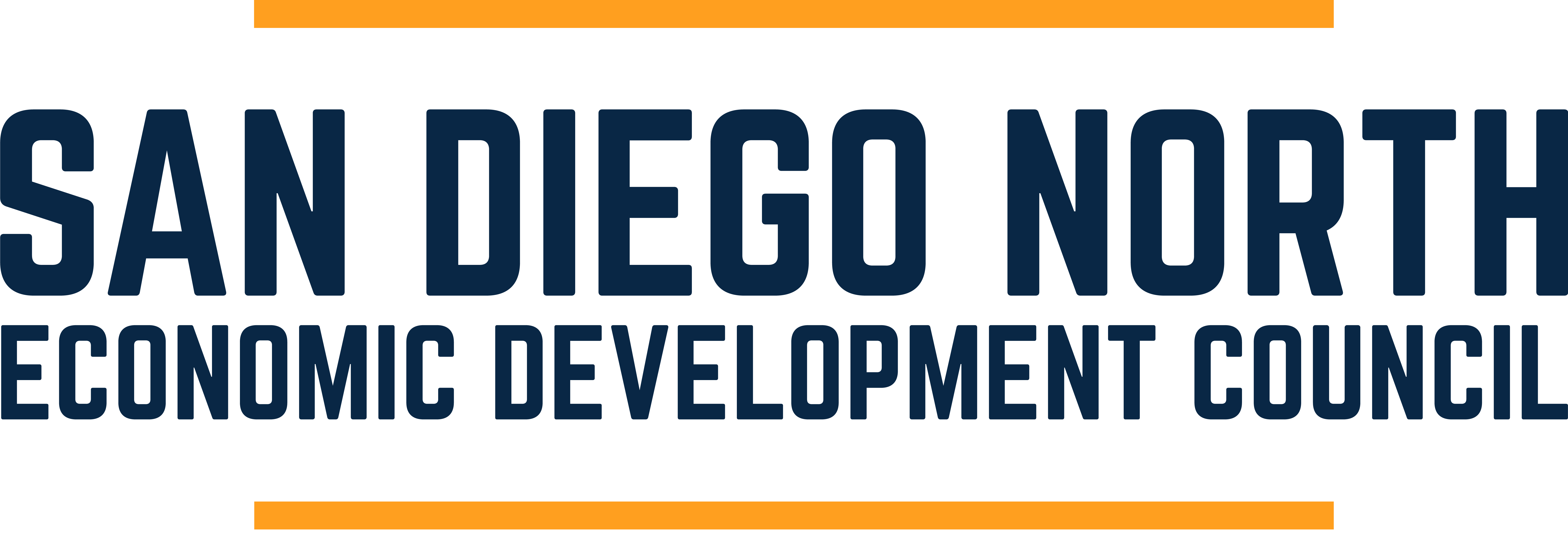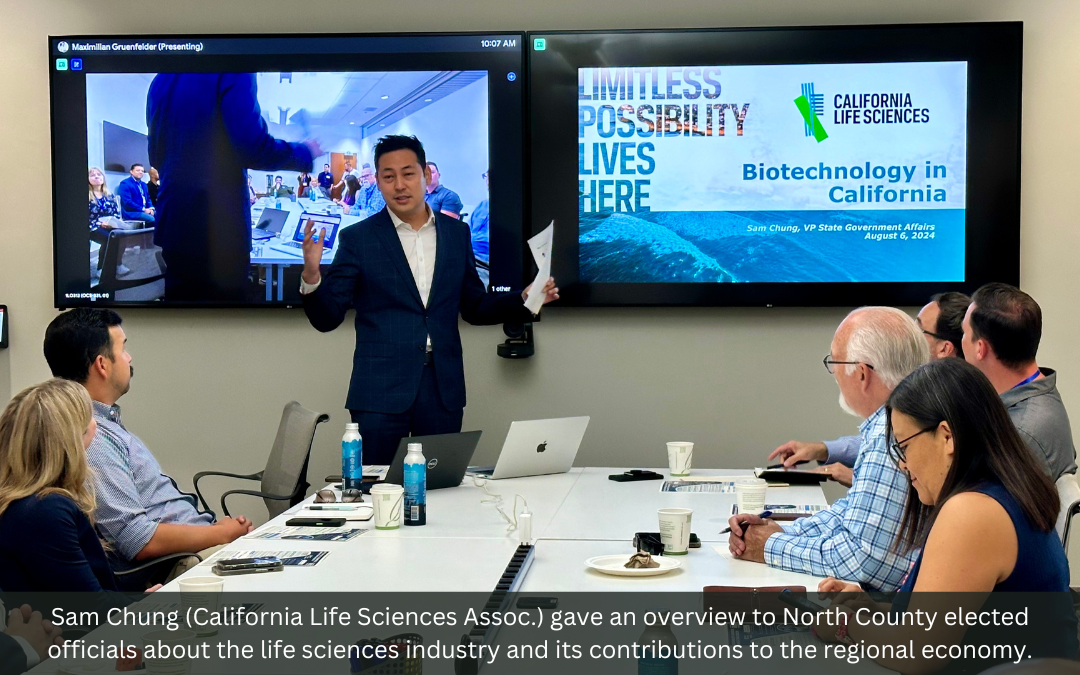On Tuesday, North County elected officials and city representatives received a briefing about the biotechnology industry, its effects on regional prosperity, and Genentech’s new commercial biologics facility expansion. This was part of SDNEDC’s “Industry 101” series – designed to educate elected officials, their staff, and other key policymakers on the industries driving North County’s prosperity. After the presentation, attendees were given a tour of Genentech’s Oceanside facility. This program was presented in partnership with Genentech and the California Life Sciences Association.

Life Sciences in San Diego County
Life sciences consist of four main areas: pharmaceutical biotechnology, medical technology and diagnostics, academia research hospitals, and sustainability in climate change. Altogether, life sciences represent the second largest sector in California, with 440,000+ directly employed individuals and a $472 billion economic output. (To put that in perspective, California’s entire state budget is $300 billion!) In North County, companies directly involved in the development of biotechnology and biomedical devices employ nearly 25,000 individuals.
California is also recognized as the number one state for life science R&D, receiving $5.5 billion in NIH grant funding (almost double that of the next highest funded state – New York). San Diego County represents the second largest life sciences ecosystem in the state with 75,458 employees.
“Life sciences and San Diego is a marriage that is just meant to be,” Chung said. “The infrastructure, the talent, the workforce – all of that is here. You can’t just replicate that.”
San Diego County also ranks third nationally for life sciences venture capital investments, signaling high investor confidence in the county’s life science innovation scene. In fact, a vast majority of life science companies in California are startups or small businesses – 90% of companies consist of 20 employees or less, and 70% consist of four employees or less.
“Small businesses form the basis for much of the R&D sector in California,” Chung said. “So passing a policy intended towards ‘big pharma’ affects that 90% as well, and it can really affect their ability to bring their drug to market.”
U.S. Life Sciences Driving Innovation
“Our identity and core is that we are an R&D (research and development) industry that drives much of the health innovation for the entire world,” said Sam Chung, VP of State Government Relations for California Life Sciences.
One example of this innovation is “precision medicine,” or medicines tailored specifically to an individual. In traditional medicine, drugs can be approved if they are effective for most patients, neutral in a smaller number of patients, and create adverse effects in a very small number of patients. This still leaves several patients without treatment options due to their unique genetics.
“Our ability to look into your DNA, your genetics, and your environment allows us to make a medication that is unique to you,” Chung said. “With these types of cell and gene therapies, you can inject them once, and they are effective for years to come.”
Challenges and Resources for Life Science Companies
On average, it takes a drug 10-15 years to go from discovery to FDA approval. Each drug can be upwards of a $2.5 billion investment, and 90% of drugs fail.
“This massive risk, and the massive investment cost goes into our final drug cost,” Chung said. Even so, drug companies provide large discounts and rebates to their buyers that often don’t make it to the end user.
California does a few things to mitigate the costs involved with the risk in drug discovery, including:
- Manufacturing and Research & Development Equipment Exemption (which helps reimburse companies for their equipment when they have reached the point of profitability),
- California Competes Tax Credit (an income tax credit available to businesses who want to relocate, stay, or grow in California), and
- Employment Training Panel (funding for training employees to enhance their skills).
New Commercial Biologics Facility at Genentech
Genentech’s Oceanside Single Use Technology (OSUT) facility is under construction and scheduled to be operational in early 2025. The new facility will produce small batch drugs at 1/8 the scale of their current manufacturing facility. This will allow them to provide drugs to smaller patient populations since they are reducing their costs of production a critical service for patients suffering from rare diseases.
“Part of the reason for locating here in Oceanside is to be near local life science talent and the opportunity to expand upon an existing facility,” said Cliff Limpman, Principal Project Manager for OSUT.

Cliff Limpmann, Principal Project Coordinator for OSUT
According to Lipmann, one of Genentech’s key strategies is to provide to both the patient and the society in which they operate. “We are blazing a trail in sustainability that isn’t based on ‘ROI’ but on ‘Return to Society,’” he said.
OSUT’s entire façade is made of solar panels, and no fossil fuels are used in the building. The facility’s technology will also significantly reduce the amount of time needed to:
- Switch from one type of drug manufacturing to another (almost instantly instead of 6+ days) and
- Transfer products from the clinical to commercial site (just days instead of 6-18 months).
All of this will help get medicines to patients faster and more sustainably.
“It’s a very unique project because it’s the first facility in our global manufacturing network for full-scale commercial drug manufacturing,” said Joaquín Castañeda, Director of State and Local Government Affairs for Genentech.
SDNEDC plans to organize more industry-specific briefings for local elected officials in the coming months, covering manufacturing, tourism, and hospitality. If you are an elected official or senior city staff member in San Diego County, please email Caitlyn at ccanby@sdnedc.org to stay in the loop for future briefings.
To receive more updates about SDNEDC programs like this, subscribe to our weekly business newsletter.
About the Author

Caitlyn Canby loves to discover and share people’s stories. She has her bachelor’s degree in Communications with over 10 years of journalism experience. An Escondido native, she lived on Catalina Island off the coast of Long Beach, CA for 15 years before moving back home to North County. She now lives a little more rurally with her husband, two children, and two dogs in the “Friendly Village” of Fallbrook. Caitlyn enjoys collaborating on projects as Chief Operating Officer at SDNEDC, traveling internationally, gaming, and exploring new restaurants, venues, experiences, and cultures.


